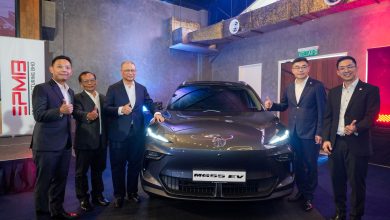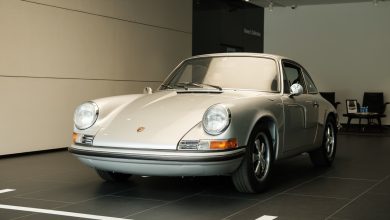The Porsche Mission R Concept Is A 1,100 PS EV Race Car

Porsche’s first all-electric race car concept also potentially hints at the EV Cayman to come.
The currently ongoing Munich motor show has been all about automakers going electric, with each and every one of the German giants unveiling a bevy of EVs in both concept and production form to showcase their respective visions for the future.
Among this sea of outlandish creations though, there are nevertheless still some cars that easily floats to the top grabbing the attention of the wider motoring world. And one such concept that perfectly fits this bill would be Porsche’s newly revealed Mission R race car, which is likely a sign of things to come for the racing ambitions of Stuggart stallion in the electrified future.

Heavily hinted by its maker for it to be the basis of an all-electric one-make racing series in the future, the specs with this Mission R concept certainly doesn’t disappoint for that particular purpose. Packing an impressive constant 500 kW (680 PS) — and delivering up to 800 kW (1,100 PS) in qualifying mode — from its two newly developed electric motors, Porsche is touting for this EV racer to be able in blitzing the century sprint in under 2.5 seconds and go on to match the lap time performance of its current race-ready 911 GT3 Cup.

This Porsche is not just fast on track too, as its standard 900 V Porsche Turbo Charging technology means that a 5 to 80% charge will be completed in just 15 minutes. Though what is probably more worthwhile to highlight in regards to its 80 kW battery pack will be the fact that courtesy of an innovative direct oil-cooled powertrain setup, there should be no derating (reduction of battery power output due to thermal conditions) experienced by the Mission R even when hammering hard around the track in race conditions.
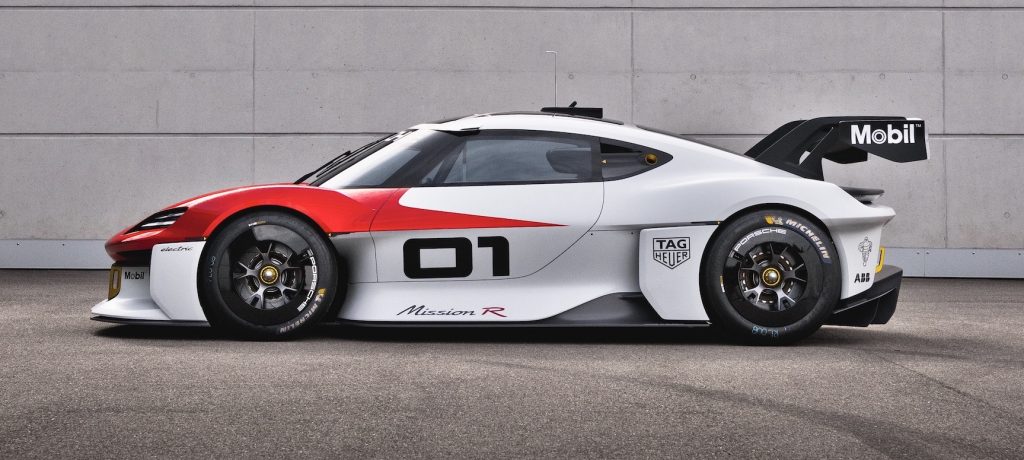
Now moving onto the body of this all-electric racer meanwhile, the Mission R’s coupe silhouette features what Porsche dubs to be ‘a further development of Porsche Active Aerodynamics (PAA) with Drag Reduction System (DRS)’ on its nose section and two-section rear wing. This concept also comes aero disks on its wheels, and a totally over-the-top rear diffuser that is only matched in outlandishness by the single-piece full-width rear light bar.
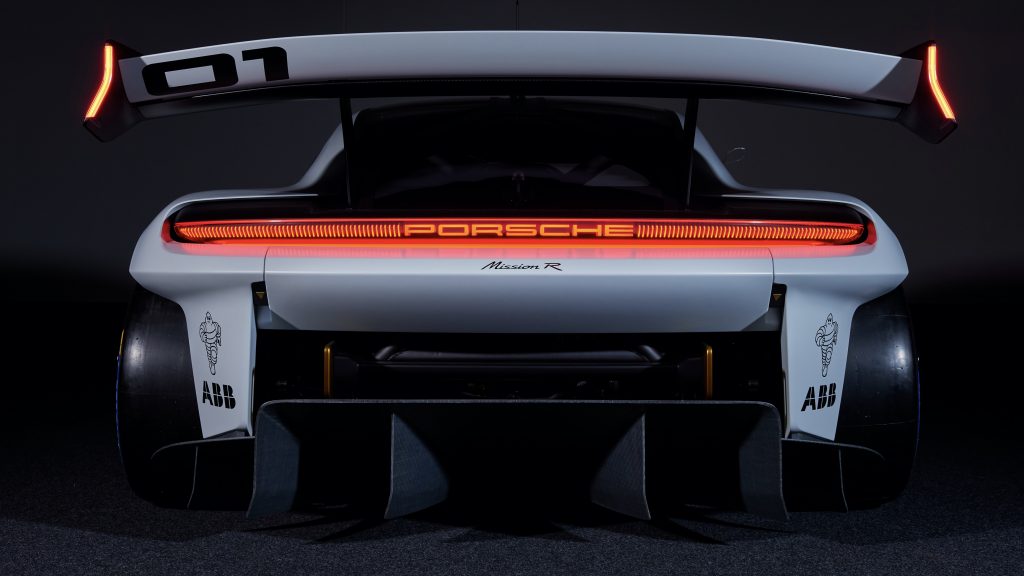
Much like every other concept on display at Munich as well, the Mission R’s body is primarily constructed from an exotic yet eco-friendly material — natural fibre reinforced plastic (NFRP) in this case — which is also used extensively in the stripped out interior of this Porsche race car. Good ol’ carbon fibre however still forms the basis of its exoskeleton roof structure, which combines the safety cage and roof skin as one unit.
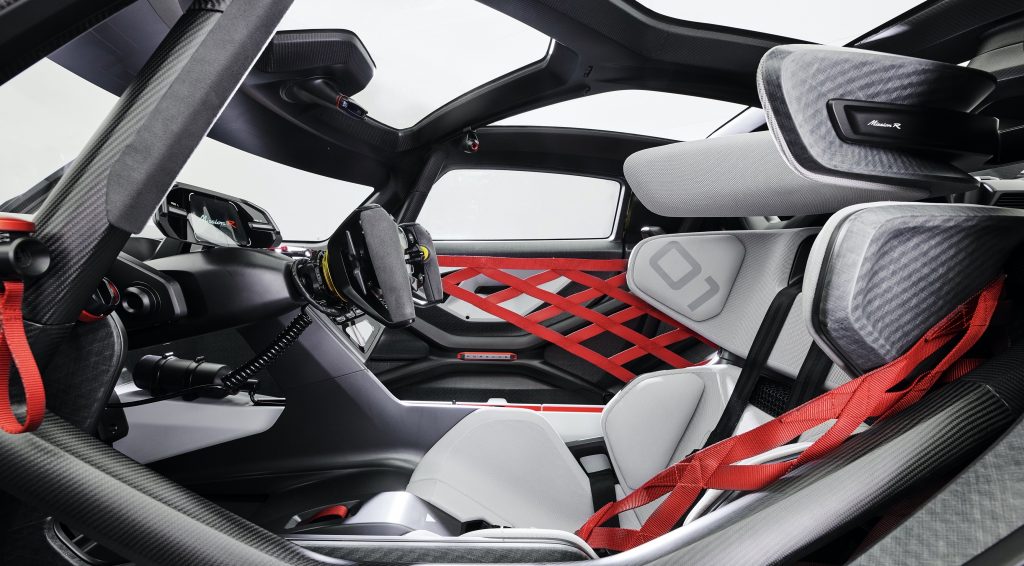
And in rounding up the highlights within, the monitor above the butterfly-style steering wheel is able to shows images from the side mirror cameras and the central rear-view mirror camera. Porsche would also like to point out that there are numerous other cameras situated in the cabin for use in racing live-stream broadcasts, while Mission R’s monocoque driver’s module is exactly the same form and can double as an e-sports simulator for its virtual racing series.

What Porsche is hesitant in pointing out however is whether or not the Mission R will be eventually making it into production or not. If how the Mission E concept eventually became the Taycan is anything to go by however, expect this then to be the very first look at what an all-electric successor to the Cayman will be some time down the line.
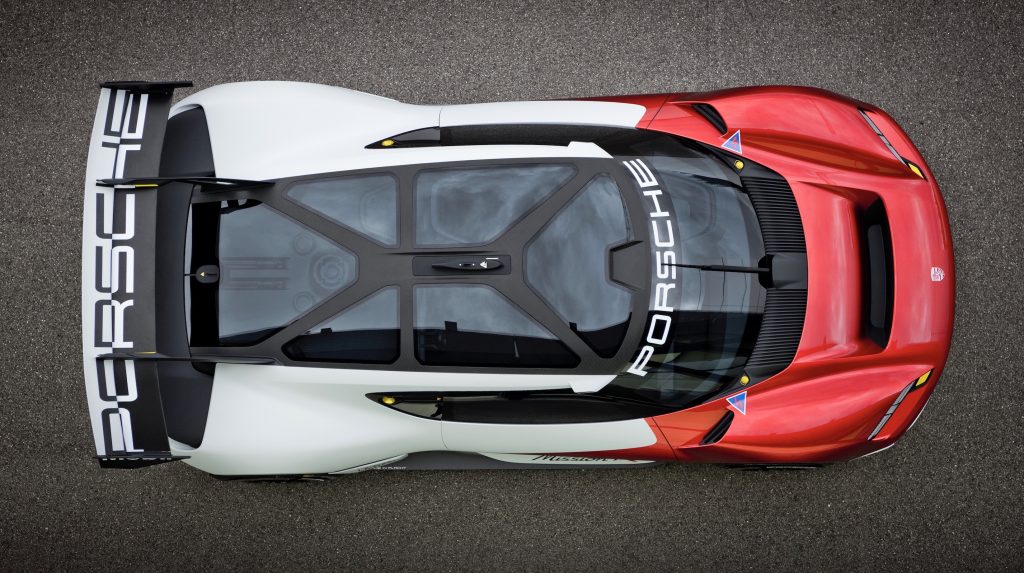
PRESS RELEASE: Right on time for the start of the IAA MOBILITY 2021 in Munich (from 7 to 12 September), Porsche is to provide a spectacular look into the automotive future. The Mission R concept car combines state-of-the-art technologies and sustainable materials, such as natural fibre-reinforced plastics, with a passion for racing.
In addition to a progressive design, the extremely low-slung, all-electric competition car features the characteristic lines of the sports cars from Stuttgart-Zuffenhausen. The two newly developed electric motors incorporated in the Porsche Mission R deliver up to 800 kW (1,088 PS) in so-called qualifying mode. The battery capacity of around 80 kWh and the innovative recuperation system make sprint racing possible with no loss of output.
“Porsche is the brand for people who fulfil their dreams. This is also true in motorsports. We experience our innovative strength on the race track, demonstrate courage in pursuing new avenues and delight car owners with sporting performance,” says Oliver Blume, Chairman of the Executive Board of Porsche AG. “In addition to our involvement in the Formula E World Championship, we are now taking the next big step forward in electric mobility. The concept study is our vision of all-electric customer motorsports. The Mission R embodies everything that makes Porsche strong: performance, design and sustainability.”
Since the start of the Porsche Carrera Cup Deutschland 31 years ago, the sports car manufacturer has produced and delivered more than 4,400 Cup cars from Weissach. A total of 30 one-make cup series are held worldwide on the basis of these reliable, high-performance racing cars. The latest version of the 911 GT3 Cup was not launched until the start of this year’s 2021 motorsport season and is based on the 992 model generation. The Porsche Mission R provides an indication of what the future of one-make series with all-electric cars could look like.
The all-wheel drive car delivering just under 1,100 PS in qualifying mode accelerates from zero to 100 km/h in less than 2.5 seconds. Top speed: over 300 km/h. On the race track, the electric racer achieves the same lap time performance as the current Porsche 911 GT3 Cup. Thanks to newly designed electric motors and battery cells – all equipped with innovative direct oil cooling – the Porsche Mission R concept study produces a constant power output of 500 kW (680 PS) in race mode. So-called derating, i.e. reduction of the battery‘s power output due to thermal conditions, has been eliminated.

900-volt technology and Porsche Turbo Charging
An electric motor with up to 320 kW (435 PS) powers the front axle, while a maximum of 480 kW (653 PS) is delivered to the rear. Thanks to advanced 900-volt technology and Porsche Turbo Charging, a good 15-minute break from racing is all that is needed to charge the battery from 5 to 80 per cent SoC (state of charge). Charging can take place with up to 340 kW. The Mission R also features a further development of Porsche Active Aerodynamics (PAA) with Drag Reduction System (DRS) on the nose section and rear wing. It comprises three louvres in each of the two side air intakes on the nose section as well as an adjustable, two-section rear wing.
In addition to the innovative, battery-electric drive concept, the body of the concept car also focuses on CO2 reduction and sustainability: it is largely made of natural fibre reinforced plastic (NFRP), the basic material of which is made from flax fibres obtained from farming. This ecological material is also used for the front spoiler lip, the diffuser and the side skirts. NFRP is used extensively in the interior of the Mission R, such as the interior door panels, the rear bulkhead and the seat.

The interior design focuses on the driver in all areas. An ergonomically placed display between the controls on the steering wheel shows relevant data during the race. The monitor above the steering column shows the images from the side mirror cameras and the central rear-view mirror camera. A touch display to the right of the seat can be used to call up the driver’s biometric data, for instance. Numerous other cameras in the interior can be used to provide exciting sequences for a live stream transmission.
With the Mission R project, Porsche is bringing real and virtual racing closer together than ever before. The monocoque driver’s module in exactly the same form also doubles as an esports simulator. The safety structure made of carbon fibre composite material combines high protection potential for the driver with low weight and a distinctive look. Porsche engineers and designers have named the newly developed carbon roof structure the “exoskeleton”. It combines safety cage and roof skin. At 4,326 millimetres in length, the Porsche Mission R is slightly shorter than the current 718 Cayman series, but it is noticeably wider at 1,990 millimetres and with an external height of 1,190 millimetres is also significantly lower.
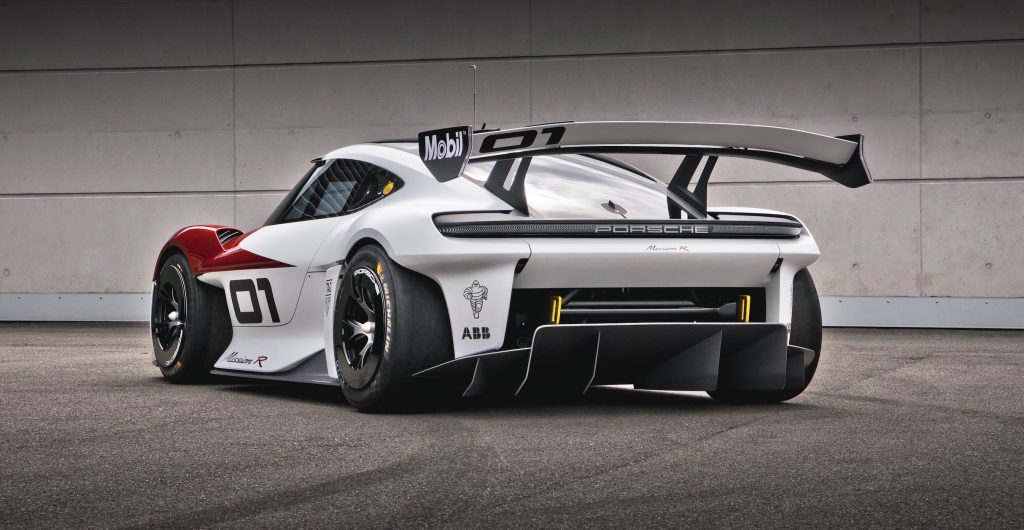
Mission E concept studies by Porsche
In the course of the last few years, with the Mission E (2015) and Mission E Cross Turismo (2018) concept studies, Porsche has given unmistakeable previews of its first all-electric sports car model series to come. The Porsche Taycan sports saloon (2019) and the Taycan Cross Turismo cross-utility vehicle (2021) closely resemble the two concept studies in terms of appearance and technology, and have already been successfully launched on the world markets – mission accomplished in other words. Now, with the Mission R, Porsche is presenting its vision of what customer motorsports will look like in the future. The show car celebrated its world premiere today at the IAA Mobility in Munich.



